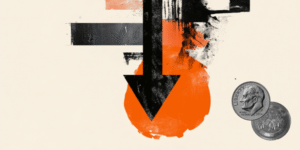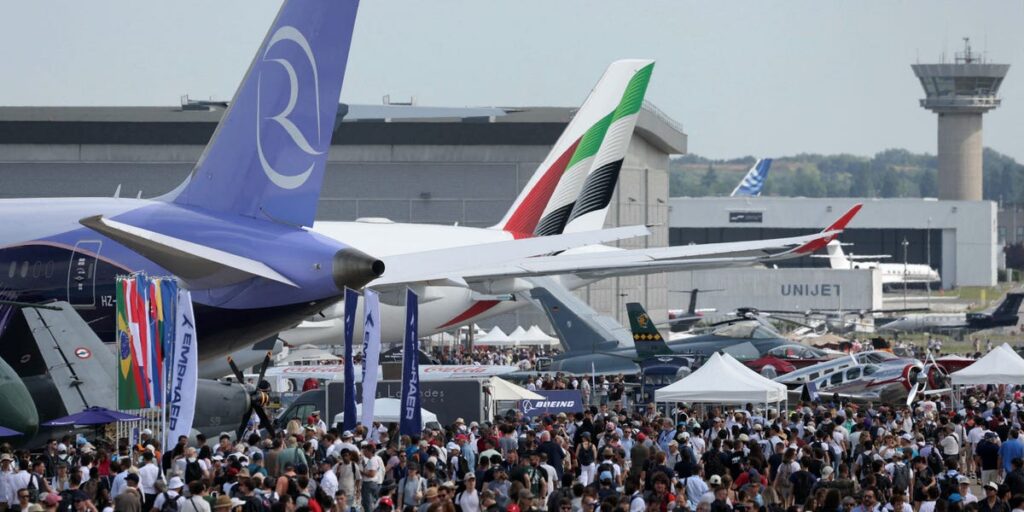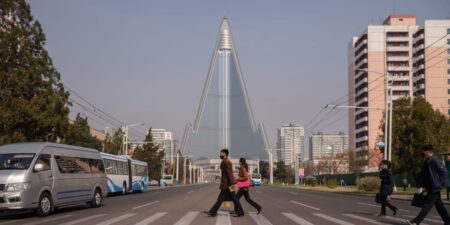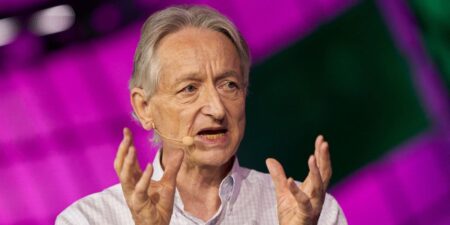Last week’s Paris Air Show came at a tumultuous time, but on the ground, the aerospace and defense industries were feeling optimistic about the future.
“It’s upbeat and people are very positive,” Chad Stecker, a supply chain expert, told Business Insider on the sidelines of aviation’s biggest event of the year.
Days before the air show began, the fatal crash of Air India Flight 171 prompted Boeing to keep a low profile. Its CEO, Kelly Ortberg, canceled his attendance, and the company opted not to announce any orders at the biennial industry gathering.
With the investigation ongoing, there was a sense of mourning rather than any concern about potential wider safety issues.
“One thing to consider about this industry is that it is one of the safest ways to travel on the planet,” John Schmidt, aerospace and defense lead at consulting giant Accenture, told Business Insider.
“Whatever happened, we’re going to find out, and we’re going to use that to make sure there’s still even more safety as we move forward,” he added.
As Airbus announced hundreds of orders throughout the show, ceremonies began with airline and lessor CEOs expressing their condolences for the victims of Flight 171.
Despite its tense competition with Boeing, criticism of a rival’s safety is untouchable.
“You don’t go there,” said Airbus’s commercial airplanes chief, Christian Scherer, per The New York Times.
“Sure, there’s a competitive landscape, but it’s that mentality of the rising tide lifts all boats,” Stecker, an executive at Incora, a supply chain solutions provider for aerospace and defense firms, told BI.
Supply chain recovery
At the previous Paris Air Show in 2023 and last year’s Farnborough Air Show, recovering from the pandemic was top of everyone’s minds.
Stecker, who has worked in the supply chain for over 20 years, said the pandemic and its consequences created “the most challenging supply-chain environment … in modern history.”
“Not a lot of people were talking about growth, and what’s beyond six inches in front of their face,” he added.
Now, despite Donald Trump’s tariff plan and geopolitical tensions threatening further trade uncertainty, the industry is finding more hope as long-term thinking takes hold and solutions become more apparent.
“Talking with everybody [at the air show], I think there’s a different life and presence,” Stecker continued.
Alexis Balloy, a consultant director at Dassault Systèmes, told BI: “Of course, there have been some crises. So here we have the pandemic, but also back in earlier times, there were other types of crises, including the economic crisis of 2008.”
“Each time the industry has recovered,” he added.
However, there is still plenty of work to be done.
Schmidt, of Accenture, said the supply chain is still the industry’s biggest challenge and is “going to be the Achilles’ heel for a while.”
He added that in any executive-level conversation he has across commercial, defence, or even space, supply chain concerns are discussed.
Air travel has exceeded 2019 levels, but that means airlines want more planes. Boeing and Airbus already have enormous backlogs, and regulators have capped the former’s production rates.
Plus, geopolitical tensions have prompted increased defense spending, especially in Europe, placing further demands on the supply chain.
So, what is the way forward?
“We see a big focus on helping the supply chain, and making it more resilient and more flexible,” Balloy told BI.
He added that the pandemic has prompted manufacturers to examine suppliers with more scrutiny, while the supply chain has become more like a cooperative network than a hierarchy.
All three men pointed to the benefits of automation and new technologies to ease constraints. For example, digital twinning — creating a virtual replica to simulate and analyse the manufacturing process.
Schmidt explained how lidar can map out a factory to help identify bottlenecks, or they can figure out when transporting freight via rail or air is more efficient.
“There’s a lot of opportunity to further leverage technology to help with agility and resiliency,” he said.
Uncertainty over tariffs was also slightly eased at the air show. According to Reuters, Transportation Secretary Sean Duffy said he wanted civil aviation to return to a zero-tariff trade agreement instituted in 1979.
Plus, optimism was drawn from innovations for the next generation of airplanes.
Balloy pointed to “emerging new technologies such as hybrid aircraft or electric aircraft, or even hydrogen aircraft.”
“The industry needs to decarbonize, even if it is just representing 2% of CO2 emissions,” he added.
New planes present a big future opportunity
Schmidt said he thought the biggest opportunity for the industry was the progress on “new market airplanes,” meaning replacements for the Airbus A320 and Boeing 737.
He wondered whether Embraer, the Brazilian planemaker, could seek to compete with the two main players, but suggested China’s upstart manufacturer Comac would have “a very limited market for quite some time.”
In a research note during the air show, UBS analysts said they expect Boeing to launch a new narrow-body plane program in the early 2030s, entering service by the end of the decade.
Airbus CEO Guillaume Faury previously said the firm’s next jet is planned for the second half of the 2030s, as it shared plans in Toulouse in April.
It will take serious planning and a lot of work for the supply chain to align with these targets, but if the optimism on show in Paris is anything to go by, the industry is up for the challenge.
Read the full article here
















